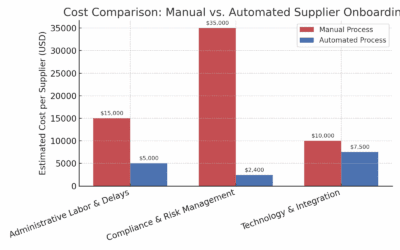Finding, onboarding, and managing healthcare suppliers can be tedious and time-consuming. But as a hospital/healthcare system buyer or procurement specialist, you know that taking shortcuts in this process can cost you time, money, and—most importantly—patient safety.
That’s why vetting and integrating new healthcare suppliers is so critical. Ensuring suppliers will provide high-quality products and services and adhere to HIPAA compliance guidelines and other regulations is paramount. Because of this, vetting and onboarding new suppliers is often tedious and time-consuming. Thankfully, there are best practices that can help you streamline your supplier onboarding process.
In this article, we’ll explore the critical steps for successfully vetting and integrating healthcare suppliers into your organization. We’ll share tips on quickly assessing a supplier’s services and capabilities so you can confidently establish goals and expectations for each partner. Let’s get going!
Develop a Strategic Sourcing Plan for New Healthcare Suppliers
The first step in vetting and onboarding new healthcare suppliers is to develop a strategic sourcing plan. This plan should include a specific set of criteria that suppliers must meet, such as:
-Compliance with regulatory standards related to the healthcare industry (e.g., Joint Commission accreditation, HIPAA compliance).
-Proof of quality and safety concerning products and services provided.
-A commitment to fair pricing agreements that represent value for the hospital/healthcare system
-The ability to provide timely and reliable delivery of goods or services.
Developing a strategic sourcing plan helps ensure all potential suppliers are held to the same high standards, so you know you’re selecting only those who can add value to your hospital system. A strategic sourcing plan also allows you to identify the features of a successful supplier relationship so that your organization can make more informed decisions when selecting new partners.
To learn more about strategic sourcing, check out these articles:
The Seven Step Strategic Sourcing Process
Multi-sourcing: Everything You Need to Know
Conducting Due Diligence: Review the Healthcare Supplier’s Credentials
Due diligence is an essential step in the onboarding process for any healthcare supplier. This is your opportunity to review the supplier’s qualifications and ensure they meet your hospital’s safety, quality, and value requirements.
Begin with a thorough review of a supplier’s credentials, including any applicable licenses and certifications. Check for compliance with state and federal regulations, such as HIPAA certification and appropriate local, state, and federal licensing. It may also be beneficial to look through reports of prior performance or customer feedback about the supplier’s products or services.
You should also review a supplier’s financial standing to ensure they are in good condition to perform their contractual duties. This review can include checking their balance sheet, income statement, and cash flow statement. Checking a supplier’s financials will help you assess their stability and help ensure they can meet their contractual obligations.
Lastly, you should check the references of previous customers who have worked with the supplier. Ask questions about product quality, delivery schedule adherence, customer service level, etc. This check helps ensure that your organization gets the best value for money from its healthcare suppliers.
Evaluating Product Quality and Safety
Another critical component of correctly onboarding healthcare suppliers is evaluating their products for quality and safety. You must have confidence in the products you purchase. This helps ensure patient satisfaction and safety and reduces the risk for your organization concerning unforeseen legal or other liability issues.
Here are some tips to help you better evaluate the product quality and safety of potential new suppliers:
- Conduct thorough product reviews: Before signing any contracts or agreements with a supplier, thoroughly review all products offered. Ensure they meet all relevant healthcare standards and regulations, and consider patient experience when reviewing products.
- Ask to see clinical results: Request product performance data from manufacturers that were generated through clinical studies or trials within healthcare environments. Doing this will provide valuable insights into the efficacy of a product before using them in real-world conditions.
- Eliminate potential risks: Assess risks associated with a new supplier before entering into a contract or purchasing any of their products. Develop protocols for analyzing potential risks, such as analyzing financial records or identifying problems with previous contracts with other customers/hospitals. Having these protocols in place will help mitigate any potential risks associated with a new supplier before being onboarded in your system.
With these best practices, you’ll be able to ensure that all onboarded suppliers meet the high standards expected by your hospital or healthcare system while eliminating potential risks associated with bringing on a new supplier relationship.
Negotiating Contracts With Healthcare Suppliers
When negotiating contracts with healthcare suppliers, keep these best practices for cost savings and risk management in mind:
Get the facts
Getting all the facts about the supplier’s reliability, quality standards, and documentation before purchasing for your healthcare system is critical. Make sure you completely understand what you’re buying, and check their references to verify their claims regarding a product or service.
Automate where possible
Automation technology can make the onboarding process much faster and more efficient while reducing risk exposure. For example, automating supplier onboarding can help ensure that all suppliers have read and agreed to abide by your hospital’s policies and procedures. The right platform will enable you to identify non-compliant suppliers quickly and take appropriate action
Use an Integrated Management System
Using an integrated management system streamlines the supplier lifecycle management process by connecting every step from onboarding to offboarding with minimum effort from your procurement department. An integrated platform like SupplierGateway’s Supplier Onboarding and Offboarding Platform also provides an audit trail of all communications between suppliers and hospitals—making it easier to pinpoint any issues that arise during the contracting process.
Onboarding New Healthcare Suppliers: Training and Integration
Another factor of successful healthcare supplier onboarding is training and integration. Without properly orienting and training new suppliers on the goods and services they will be providing and the operational processes they are expected to follow, healthcare systems often struggle with ensuring that suppliers deliver products and services in compliant, secure, and standardized ways.
After training, suppliers should understand your organization’s expectations. They should also understand how your organization measures the quality of the goods/services they provide. Additionally, new suppliers should be made aware of legal risk management issues such as contract law and medical device regulation compliance.
Once the supplier has been trained on quality assurance methods, the next step is to integrate them into your organization’s infrastructure. Integrating new suppliers into existing systems reduces time spent onboarding future vendors and helps promote the long-term loyalty of your most trusted suppliers. Technology like SupplierGateway’s Supplier Onboarding and Offboarding Platform streamlines this process with a self-service supplier onboarding portal that allows suppliers to enter their data directly into your system. This ensures that supplier information comes directly from the source and is consistent throughout your organization.
When The Relationship Ends: How To Offboard Suppliers and Reduce Risk
Knowing how to end relationships with suppliers is just as important as knowing how to start them. Reducing risk when it comes time to offboard suppliers is a crucial part of your healthcare system’s success and staying compliant.
So what processes should you have in place when ending a relationship with a supplier?
Audit Trail
First, establish an audit trail that includes the supplier’s performance. Make sure to include any issues that arose with the supplier. This audit trail will help with compliance and legal requirements, so keep it organized in an easy-to-access place.
Re-evaluate
Next, re-evaluate the supplier’s performance with your healthcare system. Did they deliver on their contractual obligations? Are there any processes that could be improved? Answering these questions will give you valuable insight into how successful the partnership was—and it may help establish expectations for future onboarding processes.
Check contracts
Finally, check all contracts associated with the supplier relationship and ensure that all contractual obligations have been met—or if they haven’t been, figure out why not. This way, you can be sure there are no financial or legal repercussions after offboarding them. Once you have settled all contracts, you can confidently terminate the relationship without risking any long-term issues or legal liabilities.
Using SupplierGateway’s Supplier Onboarding and Offboarding Platform, those responsible for supplier onboarding and offboarding can keep track of the entire process so nothing is missed or mishandled along the way.
Conclusion
Healthcare onboarding is essential for hospitals to maintain control over their supply chain processes. It requires a comprehensive, multi-tiered approach to vetting and integrating suppliers, which needs to be tailored to each hospital’s unique needs. By having a well-structured, reliable onboarding and offboarding process in place, hospitals can avoid unexpected risks and ensure that their supply chain is compliant, secure, and cost-effective.
Ready to see what our Supplier Onboarding and Offboarding Platform can do for you? Schedule a demo with one our our experts.












